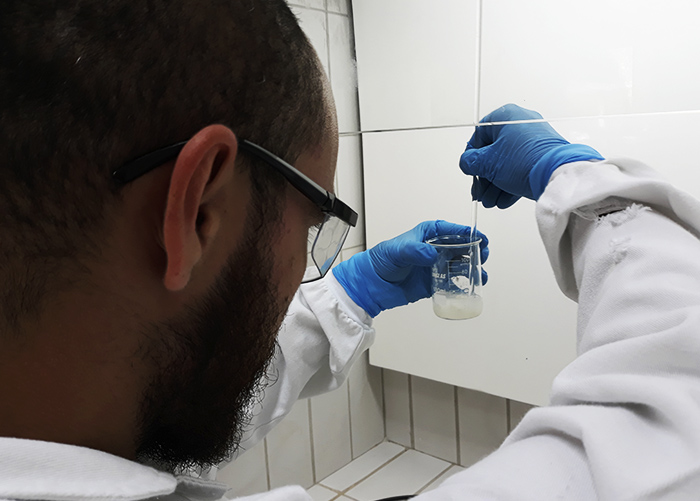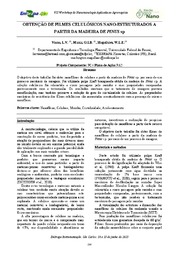Research uses cellulose nanofiber to produce controlled-release fertilizers
Research uses cellulose nanofiber to produce controlled-release fertilizers
Scientists have successfully produced slow-release nitrogen fertilizers using a nanofiber base made of pinus pulp cellulose, sodium alginate and biogenic silica nanoparticles. The study has been developed by the PhD student Mailson de Matos, from the Materials Engineering and Science course at the Federal University of Paraná (UFPR), and coordinated by the researcher Washington Luiz Esteves Magalhães, from Embrapa Forests. The main innovation is the use of a polymeric mix composed of green, renewable-sourced materials that are applied to improve the efficiency of chemical fertilizers used in agriculture and reduce the loss of nitrogen, which causes environmental damages and raises the costs of crop production.
The fertilizers developed in the laboratory met the requirements of slow release established by the European regulation on fertilizers (DIN 13266) and presented a slow release profile in water. Thus, they have potential for applications in agriculture, with the aim of mitigating the environmental impact caused by the uncontrolled release of common fertilizers into the soil and of better serving plant crops.
According to researchers, nitrogen losses vary depending on how the fertilizer is applied, ranging from 30% to 80% of the total applied. “Thus, the development of slow release fertilizers is one of the possible solutions to reduce the environmental impact caused by the uncontrolled release of nitrogen composites”, Matos asserts.
Seeking partners
The next stages depend on chemical industries' interest in the development of the product for trade. “It is still necessary to evaluate the release of the nutrient in the soil, assess whether there is a correlation between nitrogen release and the nutritional needs of the main plant crops, and the interference caused by replacing part of the sodium alginate by cellulose nanofibrils”, adds the researcher from Embrapa Forests.
For Magalhães, the development of a new product can be an opportunity for the industry, which could put a fertilizer in the market with cheaper release of nutrients compared to conventional ones.
Besides the positive environmental aspect, the new fertilizer can represent financial savings, since common nitrogen products can record nitrogen losses that reach 80% of the total applied. “Therefore, a superficial analysis reveals there is potential to replace common fertilizers for the slow-release ones, as the expectation is that the new product generates smaller losses than conventional products”, Magalhães concludes.
How slow-release fertilizers work
Slow- or controlled-release fertilizers release nutrients in a way that delays their availability for absorption, or that extends their availability, or so that the release is in sync with plants' nutritional needs. Thus, they provide efficiency in the use of nutrients and improve production yield, as the loss of nutrients is reduced.
Embrapa's work with UFPR uses pinus pulp cellulose to produce nanofibrils (fibers in nanometric scales), which encapsulate the fertilizers, making the release of nutrients slower. They also compose the coating made of sodium alginate and biogenic silica nanoparticles, produced from the plant known as common horsetail (Equisetum arvense).
The focus of the research was the process of nitrogen release by fertilizers, considering that, after carbon, hydrogen and oxygen, it is the element plants require the most. “This nutrient works as an important component of aminoacids, proteins, enzymes, chlorophyll, among other parts of the plant structure. When plants lack it, they develop yellow or pale leaves and their growth is stunted”, explains Magalhães.
The first studies revealed that adding cellulose nanofibrils to the precursory solution prevents the fertilizer granules from sticking onto each other during the drying process, which in turn prevents an increase in the nitrogen release rate. “Since adding cellulose does not significantly change the release, it can be used to reduce the amount of alginate used in the confection of granules, as it has a lower cost”, states Matos. Another conclusion is that the increase of the amount of silica in the granule accelerates the release of nutrients, but a small amount of this material makes nutrient release occur in a controlled way.
Translation: Mariana Medeiros
Katia Pichelli (MTb 3594/PR)
Embrapa Forests
Press inquiries
florestas.imprensa@embrapa.br
Phone number: +55 41 3675-5638
Collaboration:
Juliane Ferreira (MTb 4881/PR)
Further information on the topic
Citizen Attention Service (SAC)
www.embrapa.br/contact-us/sac/


